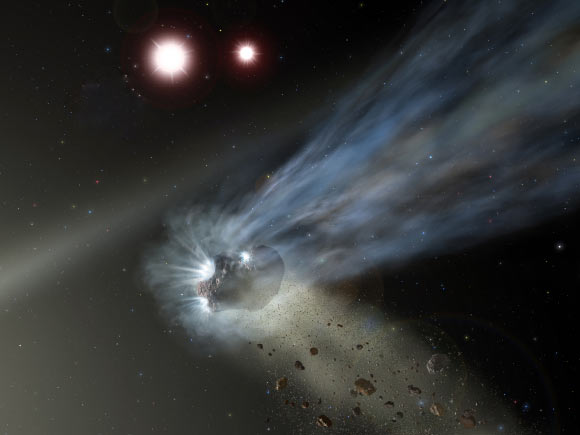Interstellar Comet 2I/Borisov Probably Came from Double Red Dwarf Kruger 60 | Astronomy – Sci-News.com
A new study by astronomers from the A. Mickiewicz University and the Space Research Centre of the Polish Academy of Sciences suggests that the interstellar comet 2I/Borisov likely came from a binary star system called Kruger 60.

An artist’s depiction of a comet and red dwarfs Kruger 60A and B. Image credit: NASA / SOFIA / Lynette Cook / Sci-News.com.
Kruger 60 is a visual binary stellar system located in the constellation of Cepheus.
Also known as DO Cephei, HD 239960, Gliese 860, BD+56 2783, HIP 110893, and ADS 15972, it is a tenth closest multiple stellar system, currently only 13.15 light-years from the Sun and approaching.
Kruger 60 is named after the German astronomer Adalbert Kruger who observed it in 1873.
It consists of two M-type stars (red dwarfs) — Kruger 60A and B — that orbit each other once every 44.6 years.
Kruger 60A has about 27% of the Sun’s mass and 35% of the solar radius, Kruger 60B is a smaller star with about 18% of the Sun’s mass and 24% of the solar radius.
Dr. Piotr Dybczynski from the Astronomical Observatory Institute at the A. Mickiewicz University and colleagues found that Kruger 60 is a good candidate for a home system of 2I/Borisov, a comet of interstellar origin discovered on August 30, 2019.
The astronomers analyzed 548 observations of the interstellar comet available from the Minor Planet Center at the International Astronomical Union.
They modeled the motion of the comet, the Sun and 647 stellar systems from their list of potential perturbers of cometary motion.
They found that one million years ago, 2I/Borisov passed Kruger 60 at a distance of 5.7 light-years having an extremely small relative velocity of 7,700 mph (3.43 km/s).
“As the orbit of this comet will become more precise the minimal distance between these two bodies might vary but their relative velocity will remain very small, which suggests that 2I/Borisov might originate from Kruger 60,” the researchers said.
Their paper was posted to arXiv.org on September 24, 2019.
_____
Piotr A. Dybczynski et al. 2019. Kruger 60 — a plausible home system of the interstellar comet C/2019 Q4. arXiv: 1909.10952






